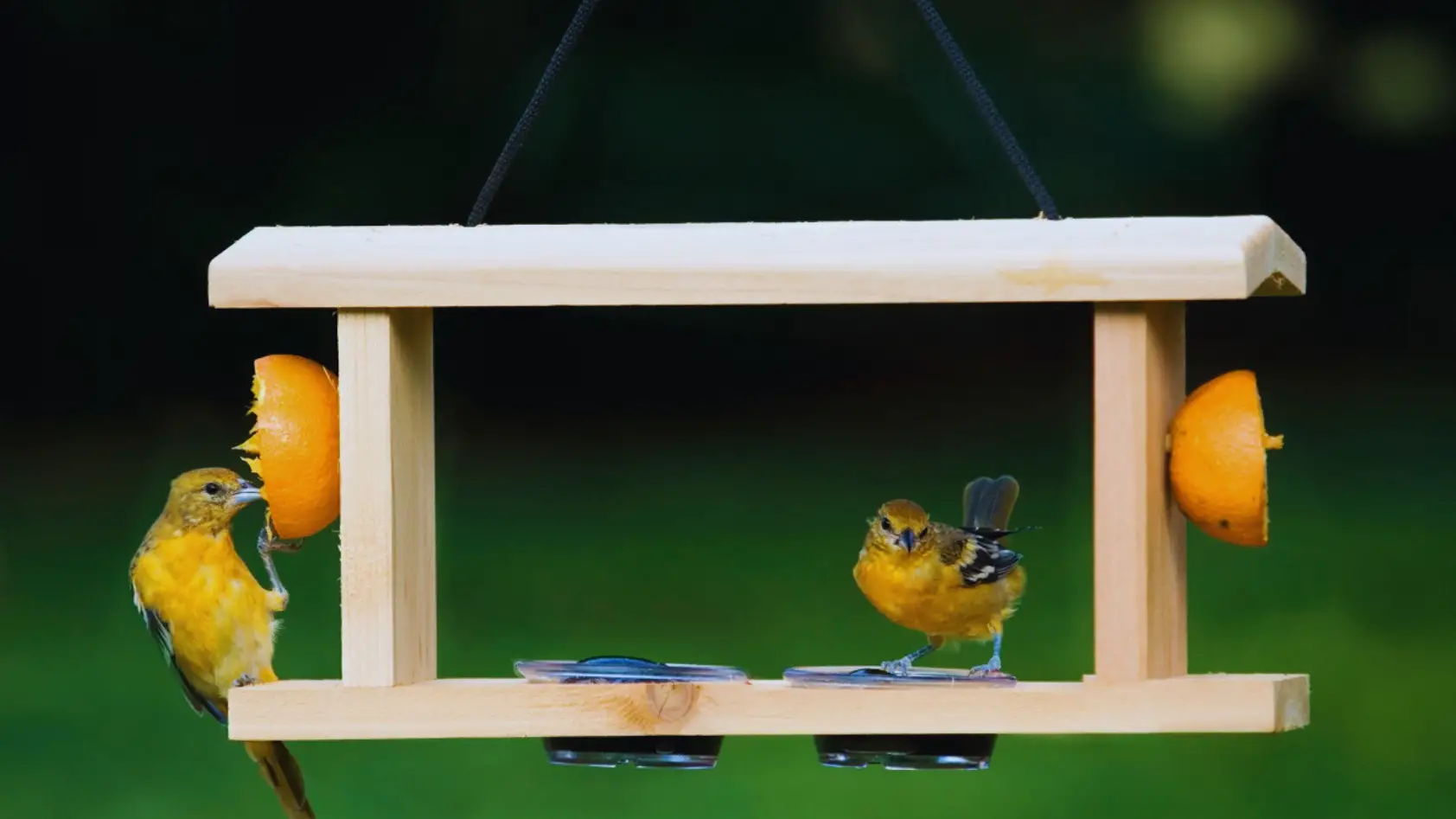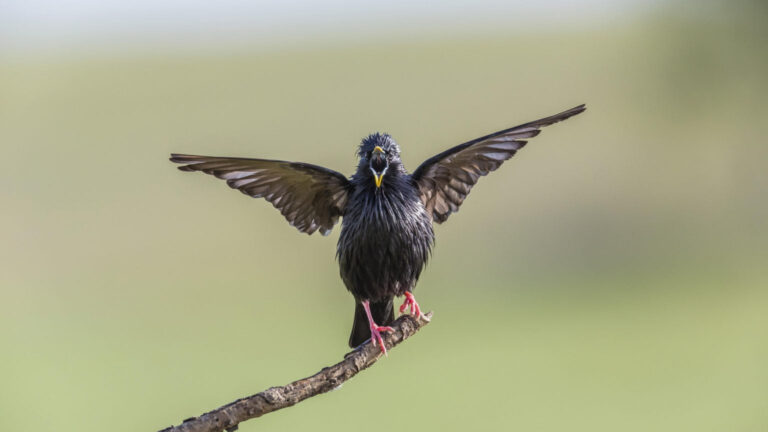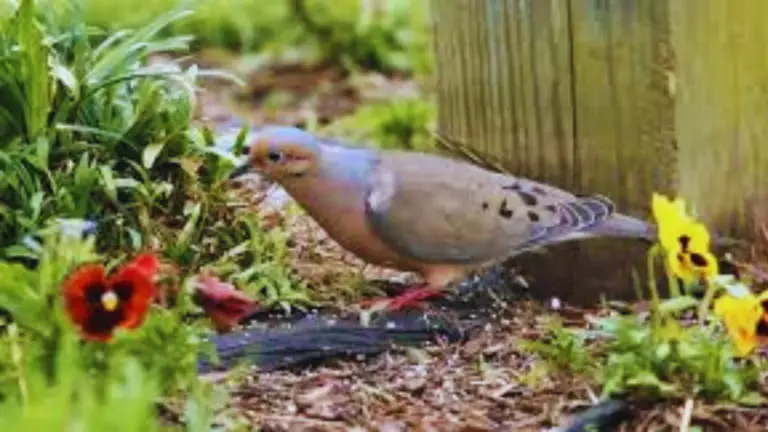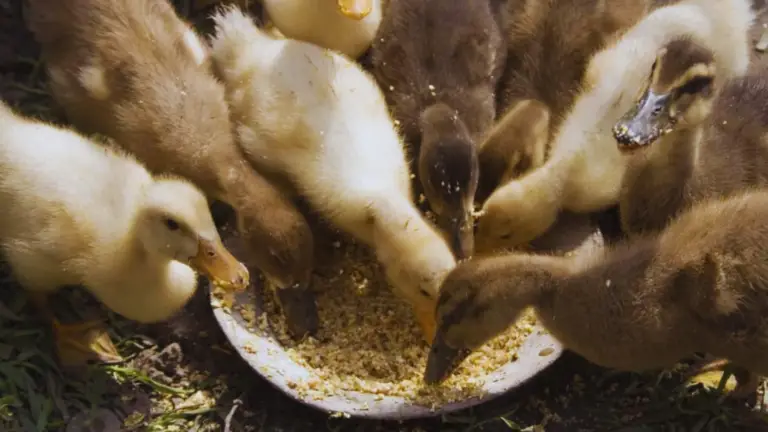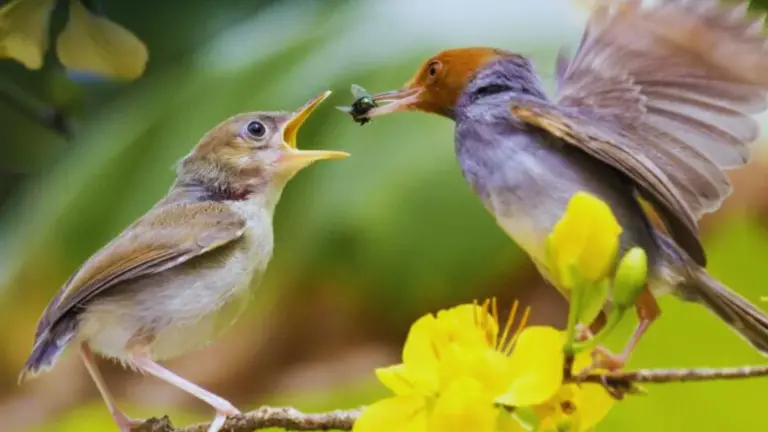Imagine creating your very own haven for the brilliant oriole birds right in your own backyard. With our DIY Oriole Feeder Guide, you can craft a sanctuary that will attract these vibrant creatures and provide them with a delightful feeding experience.
In this article, we will walk you through the steps to:
- Gather the necessary materials
- Choose the perfect location
- Design and construct your feeder
- Fill it with the right food
Hang your feeder, monitor the activity, and observe the magnificent orioles as they grace your outdoor space. We’ll even share photography tips to capture those special moments with these stunning birds. And if you encounter any issues, don’t worry, we have troubleshooting tips to help you overcome common challenges.
So get ready to immerse yourself in the beauty of nature and share your success stories of attracting these brilliant creatures to your homemade oriole haven.
Key Takeaways
- Gather necessary materials: plastic container, wooden dowel, ribbon, and string/wire
- Choose a location that provides cover and is quiet
- Fill feeder with nectar, fresh fruit, and jelly
- Clean and refill feeder regularly
Gather the Necessary Materials
Get ready to create your own haven for brilliant orioles with just a few simple materials! To start, you’ll need a few things that are easy to find.
- First, grab a sturdy plastic container, like a small food storage container or a plastic bottle. This will serve as the main body of your oriole feeder.
- Next, find a wooden dowel or a slim wooden branch that you can use as a perch for the birds.
- You’ll also need some bright orange or red ribbon to attract the orioles and make your feeder visually appealing to them.
- Lastly, don’t forget to get some strong string or wire to hang your feeder.
Once you have gathered all the necessary materials, it’s time to start assembling your oriole feeder. Begin by cutting two small holes near the top of the plastic container, opposite each other. These holes will be used to insert the wooden dowel or branch, which will act as a perch for the orioles. Make sure the dowel fits snugly into the holes.
Then, attach the ribbon to the container, making sure it hangs down below the perch. The bright colors will catch the orioles’ attention and entice them to visit your feeder.
Finally, use the string or wire to securely hang your feeder from a sturdy branch or hook.
Now that you have all the materials and know how to assemble your oriole feeder, you’re ready to attract these brilliant birds to your yard. Enjoy watching them as they visit your homemade haven!
Choose the Right Location for Your Feeder
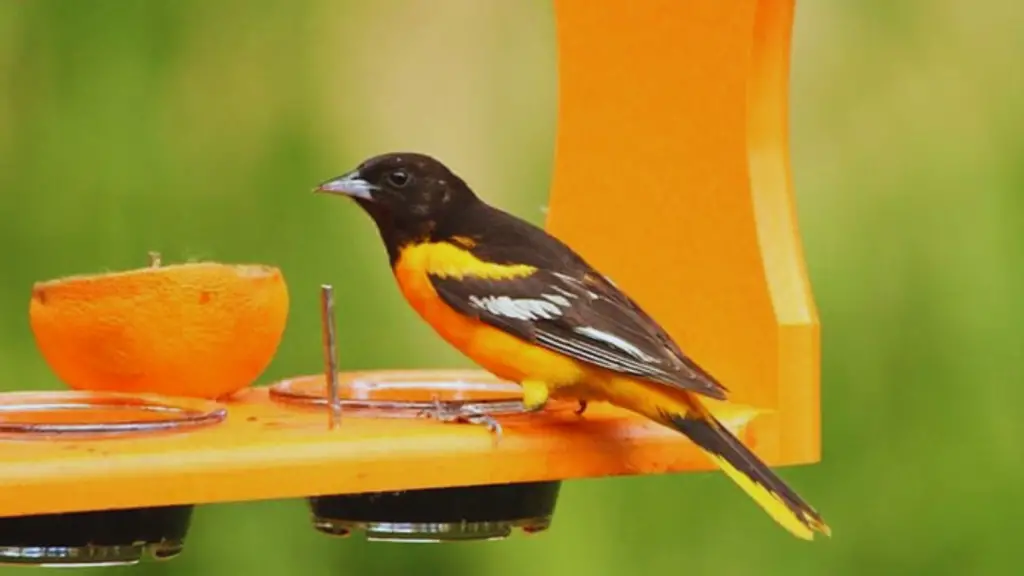
Find a spot in your yard where you can easily observe the colorful orioles while they enjoy their new feeding station. It’s important to choose the right location for your feeder to ensure that the orioles feel comfortable and safe while feeding.
First, consider placing the feeder near trees or shrubs that provide natural cover for the birds. This will give them a sense of security and make them more likely to visit your feeder. Additionally, try to find a spot that is quiet and away from high traffic areas in your yard. Orioles are easily startled, so a peaceful location will help them feel at ease while feeding.
When selecting a location, keep in mind that orioles prefer open areas with a clear line of sight. This allows them to easily spot any potential predators and quickly fly away if necessary. Avoid placing the feeder too close to windows or other reflective surfaces, as this can cause confusion and increase the risk of collisions.
Finally, consider the orientation of the feeder. Ideally, it should be facing east or southeast to catch the morning sun. This will not only provide the orioles with a warm and inviting feeding spot, but it will also make it easier for you to observe their vibrant colors in the sunlight.
By carefully choosing the right location for your feeder, you can create a haven that attracts these brilliant birds and allows you to enjoy their beauty up close.
Design and Construct Your Feeder
Start by choosing a unique and creative design for constructing your very own oriole feeder. This is your chance to let your imagination run wild and create a feeder that not only attracts orioles but also adds a touch of beauty to your outdoor space. You can opt for a simple design using materials like wood or plastic, or you can get more elaborate and use repurposed items like old teapots or colorful glass bottles. The key is to create a design that is both functional and visually appealing to the orioles.
To help you get started, here is a table with some design ideas to inspire you:
| Design Idea | Materials Needed | Advantages |
|---|---|---|
| Teapot Feeder | Old teapot, wire hanger | Unique and charming design |
| Bottle Feeder | Glass bottle, wire hanger | Colorful and eco-friendly |
| Platform Feeder | Wood, screws | Allows multiple orioles to feed at once |
| Hanging Feeder | Plastic container, string | Easy to clean and refill |
Feel free to mix and match these ideas or come up with your own. Just remember to consider the needs and preferences of the orioles while designing your feeder. Once you have your design finalized, gather the materials and start putting it all together. Before you know it, you’ll have a beautiful and functional oriole feeder ready to attract these brilliant birds to your yard.
Fill Your Feeder with the Right Food
Once your unique and visually appealing oriole feeder is constructed, it’s time to nourish these vibrant visitors with the perfect food. Here are three essential items to consider when filling your feeder:
- Nectar: Orioles have a sweet tooth, and their favorite food is nectar. To make a homemade nectar solution, mix one part white granulated sugar with four parts boiling water. Stir until the sugar dissolves completely, then let it cool before filling your feeder. Avoid using honey or artificial sweeteners, as they can be harmful to orioles.
- Fresh Fruit: Orioles also enjoy feasting on fresh fruits. Cut up oranges, grapefruits, or apples into small pieces and place them in the feeder. The bright colors and juicy goodness will attract these beautiful birds.
- Jelly: Another treat that orioles can’t resist is jelly. Choose a high-quality grape or berry jelly without any artificial additives or preservatives. Place a small amount in a shallow dish or specialized jelly feeder attached to your oriole feeder. Keep an eye on the jelly and replace it regularly to prevent spoilage.
Remember to clean and refill your oriole feeder regularly to keep the food fresh and safe for the birds.
With the right food, your homemade oriole feeder will become a haven for these brilliant birds.
Hang Your Feeder and Monitor Activity
To ensure the stability and safety of your oriole feeder, it’s important to use proper hanging techniques. Make sure to choose a sturdy branch or pole that can support the weight of the feeder and withstand any wind or weather conditions.
Once your feeder is securely hung, you can start observing and tracking oriole visits. Keep a watchful eye on the feeder and note down the frequency and duration of their visits.
Proper hanging techniques for stability and safety
To properly hang your oriole feeder for stability and safety, follow these techniques:
- Use a strong and durable rope or chain to suspend the feeder from the branch.
- Tie the knot tightly around the branch, ensuring it is secure.
- Position the feeder at a height that is easily accessible for the orioles but out of reach of predators.
- Make sure the feeder is not swinging too wildly, as this can scare away the birds.
- Regularly monitor the hanging mechanism for any signs of wear or damage.
By following these techniques, you can create a safe and stable haven for the brilliant orioles to enjoy their meals.
How to observe and track oriole visits to your feeder
To observe and track oriole visits to your feeder, follow these steps:
- Find a comfortable spot near the feeder where you can easily observe the orioles without disturbing them. Use binoculars to get a closer look at their vibrant colors and distinct features.
- Bring a notebook and pen to jot down important details about their visits. Note the frequency and duration of their visits, as well as any specific feeding patterns or preferences you observe.
- Pay attention to the time of day when the orioles are most active. This information can help you plan your observation sessions and ensure you don’t miss their visits.
- Consider setting up a camera near the feeder to capture their visits. You can review the footage later and gain a better understanding of their behavior and interactions with other birds.
Tracking the visits of orioles over time will not only provide valuable information about their behavior but also create a sense of connection and wonder as you witness their regular presence in your DIY oriole haven.
Create a Welcoming Environment
Nestled among vibrant flowers and swaying branches, your homemade oriole feeder beckons these brilliant birds to a cozy haven. Creating a welcoming environment is essential to attract orioles and ensure they keep coming back.
Start by positioning your feeder in a quiet area of your yard, away from heavy foot traffic or noisy machinery. Orioles prefer a peaceful setting where they can feed undisturbed.
To further entice orioles, plant native trees and shrubs that provide them with natural food sources, such as fruit-bearing trees or nectar-rich flowers. These plants not only offer additional feeding options but also create a lush and inviting landscape that orioles find irresistible.
Adding a water source nearby is another great way to enhance the welcoming atmosphere. Orioles enjoy bathing and drinking water, so consider placing a shallow birdbath or a small fountain close to your feeder. Fresh, clean water will not only quench their thirst but also keep them refreshed and comfortable during their visits.
Lastly, ensure your feeder is well-maintained and stocked with their favorite treats. Orioles have a preference for sweet foods like nectar, oranges, and grape jelly. Regularly clean and refill the feeder to keep the food fresh and appealing to these beautiful birds.
By creating a welcoming environment with the right positioning, native plants, a water source, and delicious treats, you’ll attract and delight orioles in no time. Enjoy watching these vibrant creatures make your homemade feeder their own cozy haven.
Maintain and Clean Your Feeder
Now that you’ve created a welcoming environment for orioles in your backyard, it’s important to maintain and clean your feeder regularly. This ensures that these brilliant birds have a safe and hygienic place to enjoy their meals.
To begin, make it a habit to clean your oriole feeder at least once a week. Start by removing any leftover nectar or fruit that may have spoiled. Use warm, soapy water to wash the feeder thoroughly, making sure to clean all crevices and corners. Rinse it well and let it air dry before refilling it with fresh nectar.
In addition to regular cleaning, it’s important to monitor the condition of your feeder. Check for any signs of wear and tear, such as cracks or loose parts, and repair or replace them as needed. This will help prevent accidents and ensure the longevity of your feeder.
Maintaining and cleaning your oriole feeder not only keeps it in good condition but also promotes the health and well-being of these beautiful birds. So, take a few minutes each week to give your feeder some TLC, and you’ll be rewarded with the joy of watching orioles flock to your backyard oasis.
Observe and Enjoy the Orioles
To truly enjoy and appreciate the orioles that visit your feeder, it’s important to be able to identify the different species that may show up. Look for key characteristics such as color patterns, size, and beak shape to determine which species you are observing.
Once you can confidently identify the orioles, you can start to observe their behavior and learn more about their unique characteristics, such as their beautiful song and impressive nest-building abilities.
Identifying different species of orioles
Spotting different species of orioles is a thrilling experience – you’ll be able to identify them by their vibrant colors and distinctive songs! These beautiful birds come in a variety of species, each with its own unique characteristics. Here are five species of orioles that you might come across:
- Baltimore oriole: With its bright orange plumage and black head, the Baltimore oriole is a sight to behold. Its melodious song will fill your garden with joy.
- Orchard oriole: Smaller in size, the orchard oriole sports a rich chestnut hue. Its sweet, flute-like song will captivate your heart.
- Bullock’s oriole: With a striking combination of orange and black, the Bullock’s oriole is a true beauty. Its clear, whistling song will enchant your ears.
- Hooded oriole: Found in the southwestern United States, the hooded oriole boasts a vibrant yellow body and a black throat. Its high-pitched, liquid call will leave you in awe.
- Scott’s oriole: This stunning oriole has a yellow body and black wings. Its beautiful song is a complex mix of whistles and trills that will leave you mesmerized.
Observing these different species of orioles will undoubtedly bring you joy and wonder as you witness their vibrant colors and hear their melodious songs. Get ready to be amazed by the beauty of these brilliant birds!
Behavior and characteristics of orioles
Orioles gracefully flit from branch to branch, their vibrant colors flashing in the sunlight. These brilliant birds are known for their distinct behavior and characteristics that set them apart from other species.
Orioles are highly vocal, filling the air with their melodious songs that echo through the trees. They have a unique way of feeding, using their sharp beaks to probe flowers for nectar, as well as enjoying fruits and insects.
Orioles are also skilled nest builders, constructing elaborate hanging nests made of grass, plant fibers, and even spider silk. Their nests are often found in tall trees or shrubs, providing a safe haven for their precious eggs.
Observing the behavior and characteristics of orioles is a true delight for any nature enthusiast.
Photography Tips for Capturing Oriole Moments
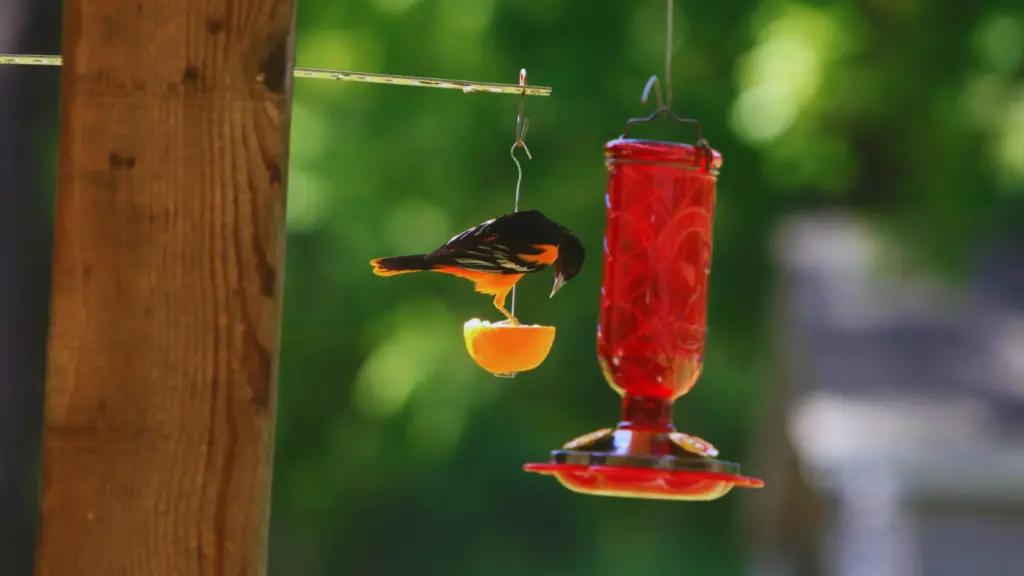
Capture those fleeting moments of oriole brilliance by adjusting your camera settings to ensure vibrant colors and sharp details. When photographing orioles, it’s important to set your camera to a fast shutter speed to freeze their quick movements. This will help you capture their wings in mid-flight and their graceful poses as they perch on branches.
Additionally, using a wide aperture can create a beautiful bokeh effect, blurring the background and making the oriole stand out even more.
To enhance the vibrant colors of the orioles, adjust the white balance setting on your camera. Choose the ‘daylight’ or ‘sunlight’ option to bring out the true hues of their feathers. Oriole feathers are known for their striking orange and black patterns, so it’s crucial to capture these colors accurately.
Position yourself near their favorite feeding spots, such as nectar feeders or fruit trees, to increase your chances of capturing them in action. Patience is key when photographing orioles, as they can be quite elusive. Wait quietly for them to approach the feeder or tree and be ready to snap the perfect shot.
Lastly, consider using a telephoto lens to get a closer view of the orioles without disturbing their natural behavior. This will allow you to capture their intricate details, such as their delicate beaks and unique markings.
With these photography tips in mind, you’ll be able to capture stunning moments of oriole beauty and create lasting memories of these brilliant birds.
Troubleshooting Common Issues
Now that you have learned some valuable photography tips for capturing oriole moments, let’s dive into troubleshooting common issues that you may encounter while observing these brilliant birds. It can be frustrating when you encounter problems that prevent you from fully enjoying the beauty of these creatures. But fear not, as I have compiled a handy table below to help you troubleshoot and find solutions to common issues you may face.
| Common Issue | Possible Cause | Solution |
|---|---|---|
| Orioles not visiting feeder | Incorrect placement of feeder | Move the feeder to a more suitable location, preferably near trees or shrubs where orioles like to perch |
| Feeder attracting unwanted birds | Feeder design or food choice | Consider using a feeder specifically designed for orioles and offering nectar or fruit instead of seeds |
| Nectar spoiling quickly | Hot weather or improper cleaning | Hang the feeder in a shaded area and clean it regularly with hot water and a mild detergent |
| Oriole aggression towards other birds | Lack of space or territorial behavior | Provide multiple feeding stations and spread them out to reduce competition |
By addressing these common issues, you can create a haven that not only attracts orioles but also ensures a peaceful and enjoyable experience for both you and the birds. So, grab your camera and get ready to capture stunning moments of these vibrant creatures in action!
Share Your Oriole Feeder Success Stories
Immerse yourself in the joy of sharing your very own success stories of attracting these vibrant creatures to your backyard oasis. It’s truly a rewarding experience to witness orioles flocking to your DIY feeder, bringing life and color to your outdoor space.
Here are four tips to help you create an irresistible haven for these brilliant birds:
- Choose the right colors: Orioles are attracted to bright hues like orange, red, and yellow. Incorporate these colors in your feeder design to catch their attention and make it easy for them to locate their food source.
- Offer a variety of food: Orioles have a sweet tooth and love nectar, jelly, and fresh fruits. Provide a diverse menu to cater to their preferences and keep them coming back for more.
- Create a comfortable environment: Orioles enjoy perching on sturdy branches or swinging on feeders. Make sure your feeder offers a comfortable spot for them to rest while they enjoy their meal.
- Keep it clean and fresh: Regularly clean your feeder to prevent mold or bacteria growth. Fresh food and clean feeding stations will attract orioles and ensure their health and wellbeing.
Share your stories of success in attracting orioles to your backyard feeder. Your experiences will inspire and motivate others to create their own haven for these magnificent birds.
Diy Oriole Feeder: FAQs
How long does it take to assemble the DIY oriole feeder?
It takes only a few minutes to assemble the DIY oriole feeder
. You’ll have it ready in no time and be able to enjoy watching those beautiful birds in your own backyard.
Can I use any type of wood for constructing the feeder?
You can use any type of wood for constructing the feeder. Just make sure it’s durable and weather-resistant. Cedar and redwood are popular choices. Consider using untreated wood to prevent chemicals from harming the birds.
What is the recommended height for hanging the feeder?
Hang the feeder at a recommended height of 5-6 feet. This ensures easy access for orioles while keeping it safe from predators. By following this guideline, you create an ideal feeding spot for these vibrant birds.
How often should I clean the feeder?
Clean the feeder regularly to keep it safe and appealing for the orioles. Aim to clean it every 1-2 weeks, or more frequently if it gets dirty faster. This will ensure the birds have a clean and healthy feeding environment.
Is it necessary to use a specific type of camera for capturing oriole moments?
No, it is not necessary to use a specific type of camera for capturing oriole moments. Any camera with decent image quality will work fine. Just make sure to focus on getting the perfect shot!
Conclusion
As you hang your homemade oriole feeder in your backyard, you can’t help but feel a sense of accomplishment. The vibrant colors of the orioles will soon grace your haven, bringing joy and beauty to your daily life.
With your camera in hand, you’ll capture these moments, creating memories that will last a lifetime.
So, sit back, relax, and enjoy the enchanting presence of these brilliant birds. Your DIY project has truly transformed your space into a paradise, straight out of a fairy tale.

